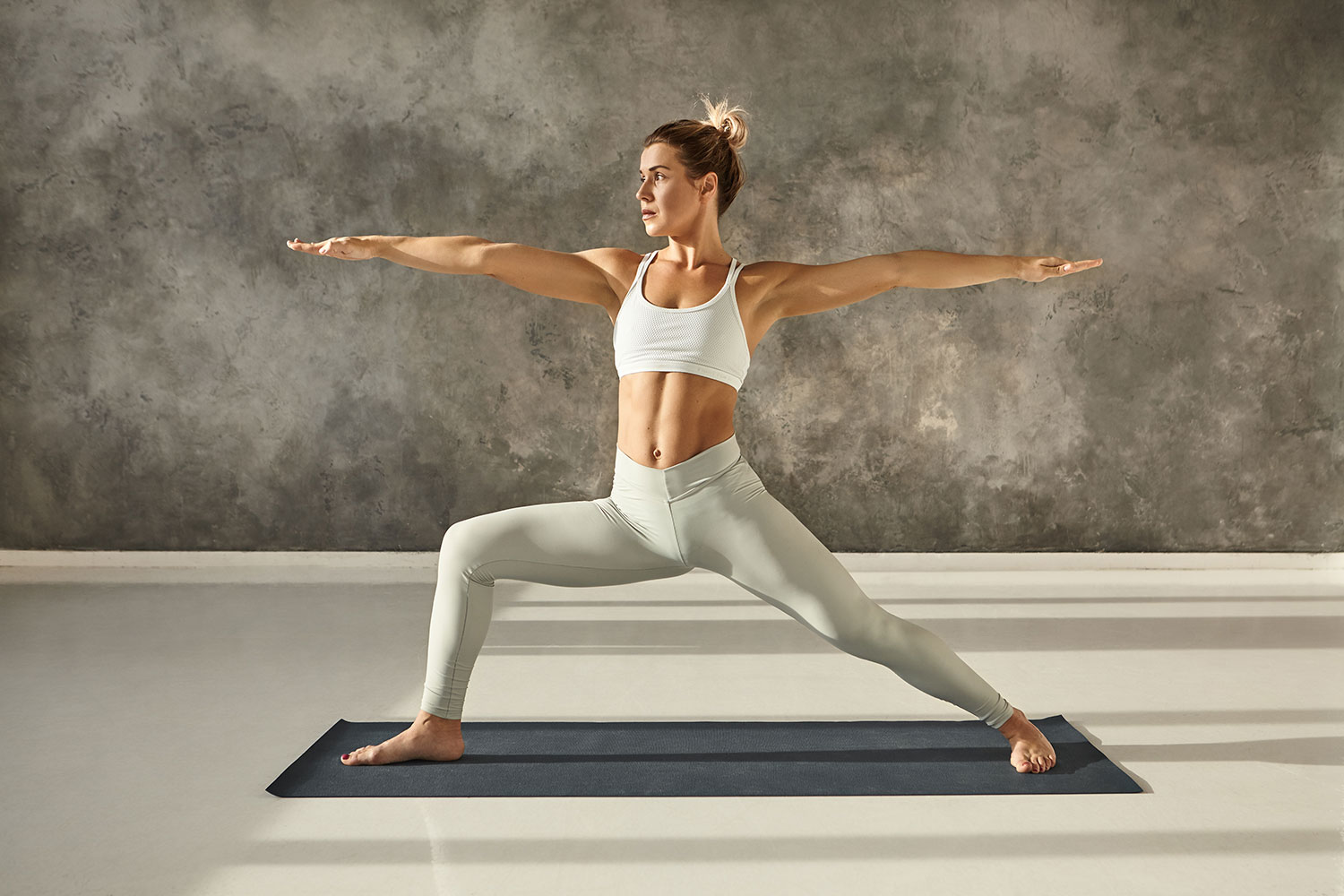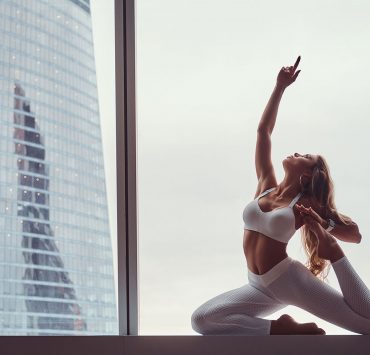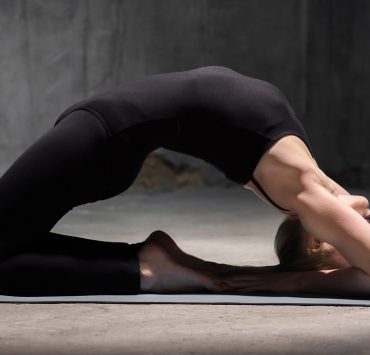
Susan views the world through a lens of spirituality, health,…
The Warrior Poses are some of the most well-known asana in modern yoga. They are pictured on ancient art work and coins from around India but as a yoga pose, they didn’t enter the practice until Krishnamacharya, the father of modern yoga, was pictured demonstrating them in the 1940s.
There are three main Warrior Poses, or Virabhadrasana in Sanskrit, and three variations which build on the basic foundations of the first two Warrior Pose stances.
Most novice yoga practitioners are able to practice Vibrabhadrasana with some variations. They are good foundational poses to build strength, stability, balance, and body awareness. These poses make you feel powerful and focused – just like a warrior!
The Story Behind the Asana

The name of the poses are taken from the mythical warrior, Virabhadra, who was a key figure in the story of Shiva and his wife, Sati.
According to the story, Shiva went into a rage when he learned that Sati, immolated herself to protest her father, Daksha, not inviting her husband to his yagna (a fire ritual where offerings are given to the gods). Shiva tore out one of his dreadlocks and it manifested into his “Radiant Warrior” form, Virabhadra.
It is said that the three main warrior poses illustrate what happens next in the mythological story.
In Virabhadrasana I, with the arms vertical, represent the warrior shooting up from the ground.
Virabhadrasana II, with the arms horizontal and straight as a sword, represent the warrior taking aim at his target.
Virabhadrasana II, with both hands forward and balancing on one foot, represents the warrior placing his prize, the head of Daksha, on a stake.
At the end of the story, Shiva is appeased by the other gods and he revives Daksha. But instead of giving him his head back, he gives him the head of a goat to remind him of his insult.
It is said that this part of the the myth reminds us to not act hastily and instead keep a level head and move with compassion – qualities which the Warrior poses also help to cultivate within us.
The Three Main Warrior Poses and How to Practice Them
Virabhadrasana I (Warrior 1)

Warrior 1 strengthens your feet, quads, hamstrings, gluteus, and core. It helps you gain body awareness to internally rotate your legs, which can be challenging for many, and also opens up your front body and chest.
This pose also teaches focus and courage. Just like the mythical warrior Virabhadra rising up from Shiva’s torn dreadlock and facing the challenges ahead.
Here’s a step-by-step for practicing Warrior 1:
- Start in Tadasana (Mountain Pose)
- Step your left foot backwards at about your arm’s length apart. Keep your hips facing forward and your heels in the same plane as your hips. Rotate your left foot outwards around 45 degrees or wherever you are comfortably able to stand.
- Bend your right leg. As you bend, ensure that your knee does not go past your toes. Aim to bring your thigh parallel to the ground so your knee forms a 90-degree angle, however do not force it if you are still developing the leg strength and flexibility.
- Maintain the bend in your knee and push your leg outwards to prevent it collapsing inwards. It will also help to isometrically rotate your right heel inwards at the same time.
- On an inhale, lift both arms up with palm facing each other above your head. Keep your shoulders rolled back and down to expand your chest and keep your spine and neck long. Point your tailbone towards the ground and keep your core activated to maintain proper posture.
- Stay in this asana for a a few breaths and release on an exhale by bringing your arms down and stepping forward into Tadasana at the same time. Rest in standing and repeat with the right leg stepping back.
Virabhadrasana II (Warrior 2)

Warrior II allows you to open up your hips and works on practically every major muscle of your body. It’s a relatively easy pose to hold for a longer period of time when in proper alignment so it works on endurance and focus.
The key is to find the ease within the effort and that balance between strength and receptivity.
Follow these steps to get into Virabhadrasana II:
- Start in Tadasana (Mountain Pose).
- Step your left leg back about your arms’ length apart. Place your heels on the same line and rotate your left foot so your toes face out at about 45-degrees.
- Bend your front leg, also making sure that your knee does not extend past your toes. At the same time, open up your hips and bring your arms to a horizontal position in the same line as your feet.
- Rotate your right leg so that your knee pushes outwards and does not collapse inwards towards the center. Elongate your spine by pointing your tailbone downwards and keeping your shoulders rolled back and down. Keep your palms in one line at shoulder height with your palms facing the earth.
- Look past your front fingertips and keep your breath deep and long.
- Stay in this asana for a few breaths before returning to Tadasana and repeating on the other side.
Virabhadrasana III (Warrior 3)

The third Warrior asana is balancing pose that increases heart rate while strengthening your legs, front and back body, and arms.
Balancing poses tend to mirror our emotions. They will immediately reflect if you are centered and balanced from within, or if you are in turmoil and unable to focus on the present. You may even feel a rise of wanting to escape from holding Warrior three pose for an extended period of time. But if you stay with it, you may find stability, both inwardly and outwards, to stay poised and focused even in a challenge.
This is one way of getting into Virabhadrasana III:
- Start in Tadasana and follow the steps to move into Virabhadrasana I (Warrior I).
- Bring you palms together and interlace your fingers, releasing just your index finger and thumb into Kali Mudra.
- Inhale deeply and as you exhale, straighten your front leg and transfer your weight into it. Hinge your hips so that your torso comes parallel to the ground. At the same time lift your back leg so that it is on the same horizontal line as your torso.
- Keep your hips on the same line and arms straight by the sides of your head. Your back foot may be flexed or pointed. Your hands, shoulders, hips, back leg, and foot should be in one line. Engage the thigh of your standing leg to strengthen it and hold the weight of your whole body.
- Keep your Drishti, or focus point, on a spot in front of you to help maintain balance.
- Hold this pose for a few breaths before returning first to Warrior 1, then Tadasana. Rest and repeat with the opposite leg.
If needed, you can modify this pose the following ways to help with stability until you develop the strength and balance for it:
- Bend your standing leg.
- Lean on a wall or on a partner.
- Change the orientation of the pose by staying in Tadasana and placing one leg perpendicular to a wall in front of you.
The Warrior Pose Variations
Although not part of the three Classical Warrior poses, these three variations build upon the alignment of the Warrior 1 and 2 asanas.
Reverse Warrior

From Warrior 2, reach forward as much as you can as you inhale and extend this arm up and back as you exhale.
Allow your back hand to rest anywhere it lands naturally on your back leg or let it wrap around your back and hook on your front inner thigh.
Look upwards or downwards, depending on neck comfort. Keep extending your front arm up and back to expand and lift your chest and lengthen your spine.
Humble Warrior

Starting in Warrior 1, interlace your fingers behind your back at your sacrum.
Inhale deeply and as you exhale, fold your upper body forward so that your shoulder contacts your front bent knee. Keep your fingers interlaced and straighten your arms behind you at the same time.
Either look a few feet on the floor in front of you or relax your neck and allow your head to hang loose. Extend your arms above your head – be mindful to not over rotate your shoulders.
No need to go all the way down, but if flexibility allows, you can bring your shoulder underneath your knee and touch the crown of your head to the floor. If you do this version, you may keep your arms behind you or release them to touch the ground for support.
Ninja Warrior

Begin in Warrior Two. Bring your palms together in Namaste in front of your chest and transfer your weight to your back leg.
Extend your front leg and bend your back leg and lower your body so that your sit bones contact the heel of your back leg.
This pose helps to open up the hips and relieve the front leg from staying in Warrior 1 or 2 for an extended amount of time.
Ending a Warrior Pose Series
Tadasana (Mountain Pose)

Start and and Virabhadrasana in Mountain Pose to rest and recenter. Stand tall and allow yourself to feel the effects of the Warror Poses in your body.
Adho Mukha Svanasana (Downward Facing Dog)

Instead of starting from Tadasana, you can also start and end a Warrior Flow series with Downward Facing Dog. Simply step your foot forward to get into the asana.
Downward Facing Dog will help to release your spine and relieve your legs from holding the strong Warrior Poses.
As an inversion, it will help with blood circulation and help to calm you after a powerful asana series. Even though Adho Mukha Svanasana may seem challenging itself to begin, with regular practice and proper alignment, it can be a welcome recovery pose too.
Virasana (Hero Pose)

Hero Pose is a good follow up pose to the series because it stretches out the quads, core, and back muscles.
This pose helps to open up the hips as well and is generally a welcome pose after an intensive leg day and can be used as an alternative to Padmasana (Lotus Pose) for meditation.
It is also a pose that allows contemplation. In contrast to the story of Virabhadra, Virasana reminds us of the story of Hanuman, the monkey god also known as Vir Hanuman. He is one of India’s most beloved gods and one of his most popular stories is in the Ramayana where he is a loyal friend and servant to Lord Rama and helps him rescue Sita.
Start in a kneeling position and open up your feet so that your sit between them. Open up your knees as much as needed to feel comfortable.
If this is too much, sit on a block or pillow.
Keep your spine long and chest expanded.
You may also move into Supta Virasana (Reclined Hero Pose) by carefully lying down, using your arms and elbows to support you. Keep your chin tucked in until you are able to rest your head on the floor. Use a bolster behind you to lay on if you are unable to reach the ground yet.
Conclusion
The Warrior Poses are important for any yoga practitioner to include in their regular practice because they teach concentration, focus, and resilience. As chest openers, they also teach compassion and patience.
At a physical level, the Warrior asanas strengthen and lengthen most major muscle groups of the body.
A Vinyasa flow class which includes all three Virabhadrasana poses plus the three variations will give a full body workout which will make you feel powerful, strong, and determined like the Radiant Warrior the poses are named after.
What's Your Reaction?
Susan views the world through a lens of spirituality, health, and compassion. Her positive outlook on life shines through her writing, which is heavily focused on yogic living, meditation, and conscious eating.














